Aphids in many Southern California vegetable gardens are particularly bad this winter. What a good opportunity to test some control methods and make observations about aphid behavior.
Brevicoryne brassicae, that’s the scientific name for the particular aphid I’m talking about. As you can see, it’s named after its host plants: members of the Brassica genus, also commonly called cole crops, and sometimes called cruciferous vegetables. In addition to broccoli, brussels sprouts, cabbage, and cauliflower, this includes kale, mustard, kohlrabi, romanesco, and collards. And as you can see in the photo above, the little buggers appear gray although under that waxy coating they’re actually green.
Warm weather
It’s been a very warm winter for us in Southern California. As it stands here on February 2, 2018, we’ve had a single day of rain, nearly every other day having been sunny and warm. Aphids love sunny and warm. Just like us, they go into a sort of dormancy when it’s very cold or hot, but revel in warm. That’s why in a normal year their population explodes around March, in between the chill of winter and heat of summer. This year so far, however, it’s been warm like spring through the whole winter.
The result? A great aphid year! — if you’re a ladybug. I’ve had more ladybugs crawling and fluttering around my garden than in any January I can recall. Lift up any leaf on a brassica plant and you’ll find a handful. Why? They’re hanging out close to their food, the aphids. If only ladybugs ate more aphids.
Natural predators / Beneficial insects
When I need information about a garden pest, one of my favorite resources is the University of California Integrated Pest Management website. On its page for these specific aphids, it acknowledges that ladybugs along with other predators of aphids like the syrphid fly and the parasitic wasp, Diaeretiella rapae, are usually capable of controlling only very low populations. “Short crop life, use of pesticides for other pests, the tendency for the aphids to be deep within the head, and various other factors make it difficult for natural enemies to keep rapidly rising aphid populations from reaching economic levels.”
This perfectly aligns with my experience, unfortunately. I’ve never sprayed any sort of pesticide in my yard, but still natural enemies of the aphids can’t control them well enough.
What harm do the aphids cause?
But let’s back up and ask what’s so bad about aphids, anyway? If allowed to colonize on a young brassica plant, aphids can grow to overwhelmingly high numbers and nearly kill the plant. They do this by literally sucking the juices from the leaves.
At lower numbers, aphids are more of a nuisance than a killer. For example, I harvested this head of cauliflower the other day.
Before harvesting, I blasted the head with water because I had noticed a few aphids. But then, upon cutting the leaves away from the head, I turned it over to find hundreds more holed up in the florets.
More than a nuisance, more than gross, it was something of a heartbreak. Months of hopeful caring for the cauliflower plant had been ruined by the discovery of these invading insects.
Pattern of invasion
Aphids invade a bed of brassicas in a curious pattern. I’ve observed this on every type of brassica I’ve grown, and it has occurred consistently every year. In short, the pattern is that adjacent plants have extremely variable levels of aphids. You might think that they’d spread themselves out among all of the plants, but no. There might be one that is terribly infested while the next, whose leaves are touching, has no aphids at all.
Because of this pattern, my approach to aphids in the past has been to just do nothing. I accept that they’ll decimate a plant here and there, which I then feed to the chickens (who also eat aphids), but they leave most untouched or barely touched. And having some aphids around as food for beneficial insects is smart, I’ve figured. I don’t want to try to eliminate them entirely. That has worked decently in the past, but not in a bad aphid year like this one.
Roguing and blasting
This year, the aphid population and aphid damage has been too high for my standards. In the bed of Romanesco from which I took that photo, out of the six plants, three went to the chickens. Normally, it might be zero or one, max. So I’ve had to try out a couple of extra control methods.
“Roguing (removal and destruction) of infested plants from the field can be effective early in the crop cycle,” says the UC IPM page. Instead of sacrificing a plant to aphids and leaving it in the bed, I’ve started to remove plants that are particularly attractive to aphids. As I said, they go to the chickens, so all is not lost. But I’d love to find out what it is that attracts aphids to some plants and not others right next door. Anyway, roguing has apparently been of some benefit over the last few weeks. It’s hard to tease out the effects of my roguing though because I’ve also started a more consistent regimen of water blasting.
Aphids are easily knocked from the leaves of brassica plants with a strong spray from the hose. I put one hand under the leaves of young plants to support them, and I also make sure to lift leaves to spray the undersides, where aphids often hide. Another place you can’t forget to blast is within the rosette of tightly curled leaves in the center of the plant. After the storm, you can see the graveyard beneath a plant.
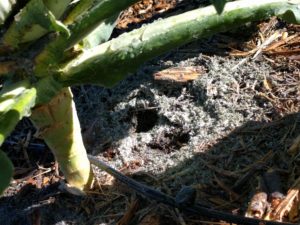
Aphids on the ground after having been blasted off the leaves of a broccoli plant using a hose with high pressure.
Not really a graveyard, some of the aphids are still alive, and you’ll see a few crawling back up the stem before long. Many will desiccate and die right there though. As long as you come back and blast the plant again before too long, the aphid population can be kept in check very well. This year since there are a lot of aphids, I try to blast every couple days.
I’ve also used the technique of wiping the aphids off with my fingers, but I mostly prefer blasting. Wiping aphids really ends up being squishing aphids. You end up with sticky aphid guts covering your fingers and the plant leaves. And there must be some substance in aphid guts that is toxic to the leaves because the leaves always look discolored and distorted afterward. Another reason I prefer blasting with water is that then you’re also giving the plants a little drink, which never hurts, especially in a dry winter such as this.
The longer I garden, the more I wish I could bottle and sell the effects of consistently blasting plant foliage with water. It cures so many pest problems: mites, scale, aphids.
Row covers and pesticides
A couple of methods of managing aphids that I’ve yet to use are row covers and pesticides. So I’m sorry that I don’t have first-hand experience to draw from here; however, a Southern California farmer I know uses row covers on his brassicas and they turn out beautifully. Row covers are those white sheets you may have seen on fields while driving through an area like Oxnard. They can serve many purposes, but one is to keep bugs off crops. This farmer says he only removes his row cover once the plant, say broccoli or cauliflower, has started forming a head. At that point, if necessary, he sprays it with a pesticide, specifically an insecticidal soap.
My sense is that brassicas are sprayed with pesticides routinely by all farmers. The University of California Integrated Pest Management webpage for these specific aphids is actually written for farmers more than us home gardeners, and it says, “Most fields require at least one [pesticide] application at preheading.” It goes on to say, “Treat as soon as 1 to 2% of plants are infested with one or more aphids.” That seems like a very low threshold to me, but imagine the raging complaint waiting for the farmer who sells a head of broccoli to a grocery store with even a single aphid on it.
Good thing I’m not a farmer. If I harvest a brussels sprout that looks like this:
I give it a peel and blast of water to make it look like this:
But notice the aphid on my finger. You’re never going to get every single one. I do this same thing to clean up my heads of cabbage when necessary.
Remember that cauliflower? Gave it a blast of water and it cleaned up pretty well:
Still, don’t look too closely. You chop it up and roast it, maybe add a little crushed black pepper and any stragglers blend right in.
(What? You’ll eat a chopped up cow but you won’t eat a little roasted aphid?)
HERE is a post about using dish soap to control aphids on broccoli and cauliflower.
A list with links to all of my Yard Posts is HERE

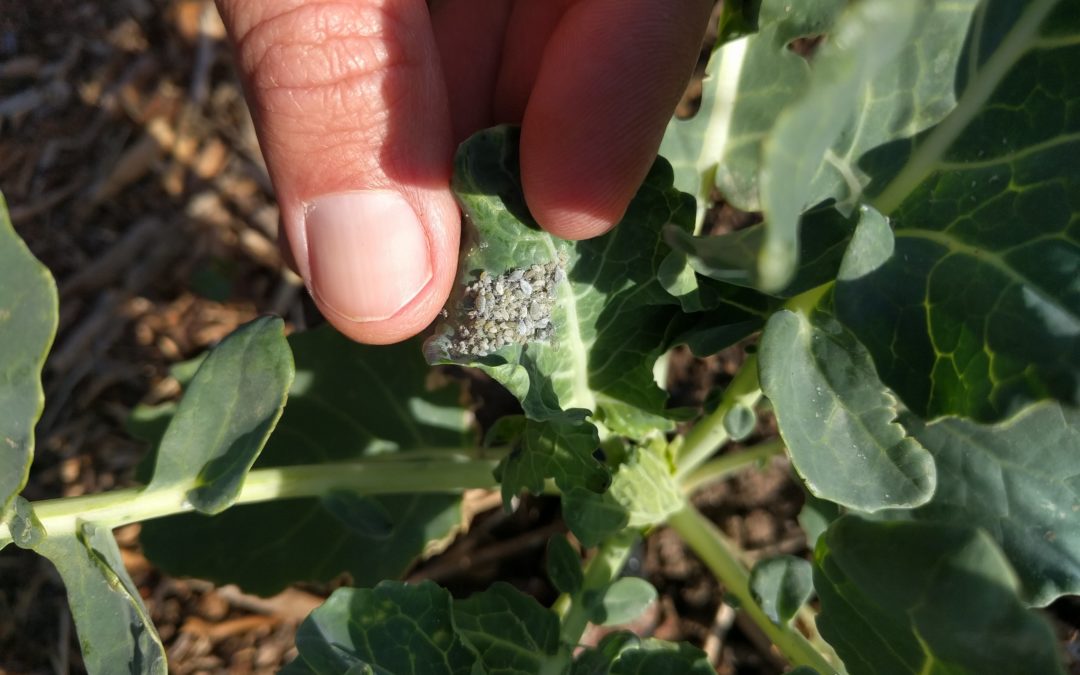

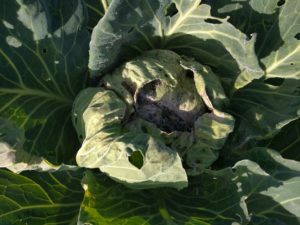
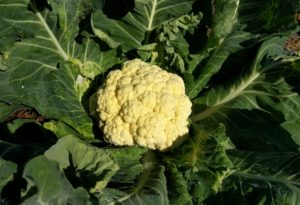
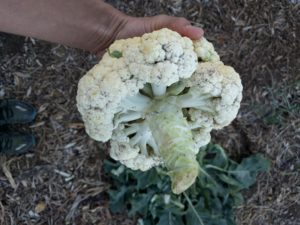


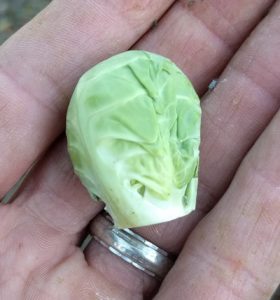
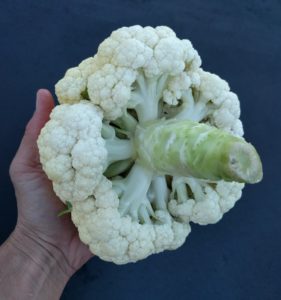
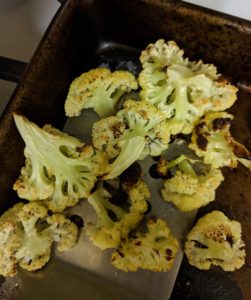


Thanks for the info. Darn critters! The bugs have been especially bad this year- moths, spiders, earwigs… I’m working on eliminating the grubs that grow into Japanese beetles in my garden. After consulting with a couple of local nurseries and a friend who knows agriculture, I’ve gone the nematode route instead of pesticide. We’ll see if that works. Fingers crossed! I’ll let you know!
Oh, never heard of nematodes controlling beetles. Interesting. Keep me posted.
Yellow drinking cups turned upside down, attached to anything permanent and near the affected plant(s), lightly coated with Vaseline. Solo cups work well as they are durable, but waxed paper cups should work also (have not tried them).
Aphids are attracted to yellow, which is the color of the bottom leaves of many brassicas.
Hi..great article! Im having the same problem, have you tried the soapy spray solution with reg dishsoap?? I have no problem hosing them down, just wondering if a soapy spray will do the trick..or is it just a myth ?
Hi Aj,
I have not tried regular dish soap. If you try it, please let us know what you observe. Also try to compare it to just spraying water.
I use the dish soap solution every year. It works great. I’ve also hit them with the water spray, but have better luck with the dish soap. It also works for many other bugs besides the aphids. It’s my go to solution for all of my garden.
Thanks, Cindy. Which dish soap do you use, and how much do you dilute it?
I use whichever one Costco sells! Right now it’s Palmolive, but in the past I’ve used Dawn. Any brand seems to work. I put a normal squeeze into a 16 ounce bottle. Enough so that the water has a slight tint of the soap. I spray till the plant is wet all over and make sure to spray under the leaves as well. I do this for a couple of days and then keep a close eye. If there are any signs of bugs I go at it again.
I found this site which gives good information.
https://www.thriftyfun.com/Dish-Soap-for-Aphids-2.html
I’ve tried it and it worked really well. It save my cabbage but I didn’t see them on my brussels sprouts in time and they’ve just about sucked the life out of them.
Hi thank you this is very helpful. Currently aphids have completely covered my Russel sprouts but have not touched any outher crops. If I take them out, will the aphids move on to my other plants? Should I leave them as a sacrifice? At this point it’s more annoying than anything.
Hi Lesli,
This is a dilemma I’ve thought a lot about too. I don’t think it matters either way. I’ve left the plants and haven’t noticed a change in the level of aphids on other brassica plants nearby, and I’ve removed them and also not noticed any change.
In fact, I did this just a month ago. I finally removed my “aphid trap” Brussels sprouts plant, but since then I haven’t noticed any extra aphids on nearby cabbage, kale, mustard, etc.
Since it annoys you, I say rip it out!
I have quite an infestation of aphids on 3 of 4 Brussels Sprouts plants in my container garden. I did things backwards and tried Neem oil first. The very next day I still had quite a lot of activity on the plants so I decided to clean them off with a stream of water. I used an empty planting container to catch the water I was spraying on the plants so ideally they couldn’t climb back on the plant and skipped the Neem oil this time although I think in the future applying the Neem oil at this point would be best. Right now my plants appear clear of aphids but all the spraying loosened the root system (it took a lot of spraying and wiping them off my hand in the nooks and crannies of the leaves) that I had to add supports to my plants. I plan to do this method consistently until the aphids are in check.
Brussels sprouts always get aphids worst, but I think that if you continue to keep them in check by consistently blasting them with water then you will get a harvest. You’ll still probably have to peel and discard the outer leaves. I wish you luck!
Michl, I did the same exact thing! Started with the Neem oil Bc I read somewhere not to waste my time trying to spray the aphids off because they have such great suction to the plant. Well, the neem oil may have worked but at the same time it basically burned several of the leaves on stems. At one point, I thought I had won the aphid battle only to find they’reeeeee back…such a defeating feeling especially since this is my first go at brussels. I will try the power spray method followed by light follow up with the neem oil. Fingers crossed!
I have Aphids on moth Brussels Sprouts and Broccoli this year, BAD! I live in Texas where we have had a mild, wet winter. I use Dawn in my soap spray, three teaspoons to a gallon with a teaspoon of corn oil, kills them Dead! Yeah!!! We have had so much rain, I don’t feel comfortable using the water spray technique. Good Luck everyone and stay safe!
Hey Greg, I found a curled web in a washington navel orange leaf and was about to pick it up when I realized there was a large spider alive inside with its egg sac. So it’s not a mite or little worm thing like I’ve seen in previous webby curled leaves. It’s a full on crawling spider inside. I paused because my general philosophy is spiders eat bad bugs. Should I keep her around? Friend or foe? Thoughts?
The tree doesn’t seem to exhibit any chewed leaves or anything.
Thanks!
Hi Mark,
I’d leave the spider alone. In general, they’re beneficial predators that keep some insects in check. Here’s a gallery of some common garden spiders in California: http://ipm.ucanr.edu/QT/commongardenspiderscard.html
Found it through that link you shared. Yellow sac spider. Fascinating creature to read about. And beneficial in a garden. Happy I left it. Thanks!
Yaaay! I’m happy you left it, too!
This made me laugh! Thank you so much for the info. I feel a lot better now. This is my first year gardening and these aphids are the first major insect attack I have seen. My initial gut reaction was well I guess I have to rip them all out now!! But then the other part of my brain was like, uhhhh… That isn’t the kind of gardener I want to be. Hah. So back to the drawing board! I am happy to learn they are not as big of a nuisance as some other people make them out to be. I have noticed too that they all culminate on one or 2 plants and leave the others untouched! I assumed any minute now they would migrate over, I am glad to hear that may not be the case. Gonna go grab a soaker hose and blast ’em. And I don’t eat cow, but I use a lot of black pepper. ? So…. *looks the other way*
Hi Monique,
I like your attitude! I’ve been blasting aphids off my broccoli, caulflower, and cabbage daily the last week or two. Just a quick walk down the bed once a day. The broccoli and cauliflower are heading up now so I’m sticking the hose into the center where the aphids like to hide. Appears to be keeping the population very low at the moment.
Hi Greg, question for you about the fallen aphids after a good power spray:
Will the survivors not infest other plants?? I feel like it would give them free range on the crop. Please advise. Thank you!
Hi Megan,
I know it seems like that would happen, but for whatever reason I’ve never seen it actually happen. Try it and watch.
UC Riverside has a big study using KM Ant Pro bait stations to control aphids in citrus groves. For the past five years, since discovering, I have 6 dilute boron filled bait stations on a 1 acre garden. No Argentine ants and therefore no aphids. The natural predators are not driven off by ants. Further, no ants in the house with California winter rains.
Developed by entomologists, non poisonous (except mechanically in the gut of various pests)
http://ipm.ucanr.edu/PMG/PESTNOTES/pn7411.html
http://www.kmantpro.com/
Hi Tony,
Thanks for sharing your results with KM AntPro. I also use these bait stations, and in fact I’ve got a post about them planned for the next few weeks. My results haven’t been as dramatic as yours, unfortunately. The results have been good but not complete eradication. Do you really not find any more Argentine ants? And do you really not find any more aphids?
Your comment has me thinking I should locate a station right next to a bed of brassicas and observe the aphid levels in that bed. Thanks for the contribution.
I read about first on the IPM website. I talked to the investing entomologist, read the studies and thought nothing ventured nothing gained.
Aphids on artichokes, citrus, lupine, brassicas and every winter ants in our kitchen.
Yes these bait station work. Dilute sugar/boron solution with the ants carrying stuff back to nest instead of dying enroute is the suggested mechanism.
I buy the liquid at epest by the case and fill each station by weight, 250 grams of bait and 250 grams of water. I check and refill Stations last a few weeks after the initial kill when there might be enough ants to drink all in a week.
After no more ants, the natural predators eat the aphids. Even seen small wrens having a meal
Science at work.
Thanks for you posts. I was referred by a person at Four Winds after I asked questions about a Reed avocado I bought recently
Best
Tony
Awesome, Tony. Thanks a lot. It’s very encouraging to hear your results in a situation similar to mine. I’m also on an acre and growing many similar plants.
I happen to have recently attended two webinars that spurred me to refill my KM AntPros and place them better. One webinar was with Mark Hoddle of UCR and the other was with Ken Kupfer, inventor of the KM AntPro. I learned a lot from both, and I am now getting much better results from my stations than I did last year.
I currently have a station under a lime tree that is only about 15 feet from a row of brassicas so I’ll be watching very closely to see the ant-aphid populations on those brassicas in the next few weeks.
Hope your Reed is growing well.
Greg, keep the stations filled, measure and dilute 1:! sugar/boron with water, each station will hold about 500 grams/ml (I use a metric scale to weigh solutions, ~250g of each.)
Move the stations as you see activity. I leave mine year round with winter being more quiet. Liquid doesn’t seem to degrade but some times evaporation leaves a sticky residue inside the base to be cleaned with an old tooth brush.
BTW, with your acre of plants. Check out Infaco pruners. They can cut up to 40mm branches all with one hand and therefore no need for the clear area necessary with loppers. Also they sell a carbon fiber pole device for higher limbs. Each year I send in for service; with the internal chip keeping track, last year I made 19600 pruning cuts. Other brands but Infaco has many attributes.
Awesome post! I grew my first brassica (cauliflower) and it bolted, another story entirely, but i left it in to see what it’d do after it stopped flowering. I’m extremely inexperienced with gardening so I thought I was looking at a fungus until I noticed it was crawling. Fascinating creatures, though. I love the point you make at the end about the cognitive dissonance in eating a chopped-up cow but wigging out over a little old aphid.
Ive also noticed the same pattern. Out of 6 broccoli plants, they only infest one. The question is, do i leave that one in for as a sort of sacrificial gesture – thereby leaving the colonies satisfied and not taking another plant? or take it out completely from the bed & away from the clean ones?
Aphids, GRRRRRRRRRRR! I once had a volunteer cherry tomato grow in my front yard. It bore fruit year around for over 2 years. I’d had to battle ants/aphids many times to keep it alive. But it finally died, and I pulled it out of the ground roots and all. Then I found why it died. The ants learned to plant their herd of aphid cows underground on the roots where I couldn’t see them. GRRRR! How I wish I had saved some seeds from that vine. That was before I got serious about planting my own veggies.
Aphids transmit diseases and it seems worst when they are tended by Argentine ants. One year every tomato plant made fruit with stunted, mottled, inedible flesh.
Thank you! I’m growing collards for the first time (in a 9b garden in Oregon). This post was super helpful because… you guessed it… I have cabbage aphids!